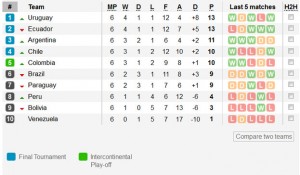Two days after the end of another South-American world cup qualifying week we can see why South American world cup qualifiers are known by many people as the “toughest qualifiers on earth”. As of right now, there is a difference of 3 points between the first place team (Uruguay) and the 5th place team (Colombia) that will be disputing an intercontinental play off to go to the world cup. Even more impressive is the fact that there is a 4 points difference between the 1st and 7th team (Paraguay) in the qualifying table!
The small difference of points between the teams shows the minor difference in the level of play that exists among them. South American soccer has greatly improved over the past decade. While 10 years ago Brazil and Argentina dominated the qualifying competitions and were overall the best teams in South America, right know, other teams like Uruguay, Colombia, Chile, Paraguay and Ecuador have improved their soccer and reached an almost similar level of play to old powerhouses, Brazil and Argentina. Almost every country of the previously mentioned list has at least two players in very important teams in Europe, showing that the Brazil and Argentinian dominance is something of the past. In Colombia for example, players like James Rodriguez, Juan Cuadrado, Carlos Bacca, David Ospina are all part and important players in historical teams in Europa such as Real Madrid, Jueventus, Arsenal among others. A similar case is seen in Chile, were players like Arturo Vidal, Claudio Bravo and Alexis Sanchez are very important members of teams like Bayern Munchen, Barcelona and Arsenal. This trend is also seen in other countries like Ecuador, Uruguay and Paraguay, where a good amount of players are part of of recognized European teams.

Image from “fichajes.com”. Colombian James Rodriguez is one of the rising stars of South American soccer.
The playoffs are so intense right know that 5-time world champion, Brazil, is currently eliminated of the world cup. The “cariocas’ had a bad run on the last two recent games, drawing 2-2 against both Uruguay and Paraguay. The fact that Brazil is right now not going to the world cup, has started talk among many commenters of soccer in which they question Brazil’s recent history and if it still deserves the tittle of “soccer powerhouse”. Again, Brazil’s case just serves to emphasize the idea that other South-American teams have improved impressively over the last 10 years. 10 years ago, Brazil had no trouble making runs on the qualifiers being very common to see the “cariocas” at the top of the table after every qualifying match. However, the improvement of other South American teams, have made games a lot more difficult, making Brazil’s qualifying run’s a lot less smooth. Brazil is definitely still a powerhouse of soccer, most of its players are part of the best teams in the world and their technical skills are undeniable, however, as said through all this article, they are now living in an era were their South American fellow countries have learned from them. These new rising powerhouses of soccer are starting to everyday send more and more players to top teams in Europe and our starting to develop the technical skills that have for so long characterized top national teams like Argentina and Brazil. The South American qualifiers are only beginning and many things can still change, but on thing is for sure: it will be a very close battle for Russia 2018.


You make a great point, Cipriano. Earlier in the course, we talked about how the teams with greater financial advantages tend to be more successful in general. It is great to see the leveling of the playing field in in South America. The fact that Brazil is an underdog for Russia 2018 at this point is mind boggling, and historically unprecedented. Overall, however, this is great for soccer as a sport in general, because this is what makes watching sports so great. There is a direct relationships between the proximity of level of play and overall entertainment of the game. That is, when two teams are similarly skilled, the game will be more fun to watch as it will likely be closer in score. When there is such a disparity between the top and bottom of the rankings, the outcome of the game is expected, and often unsurprising. Thus, there is true beauty in the leveling of the playing fields in South America.